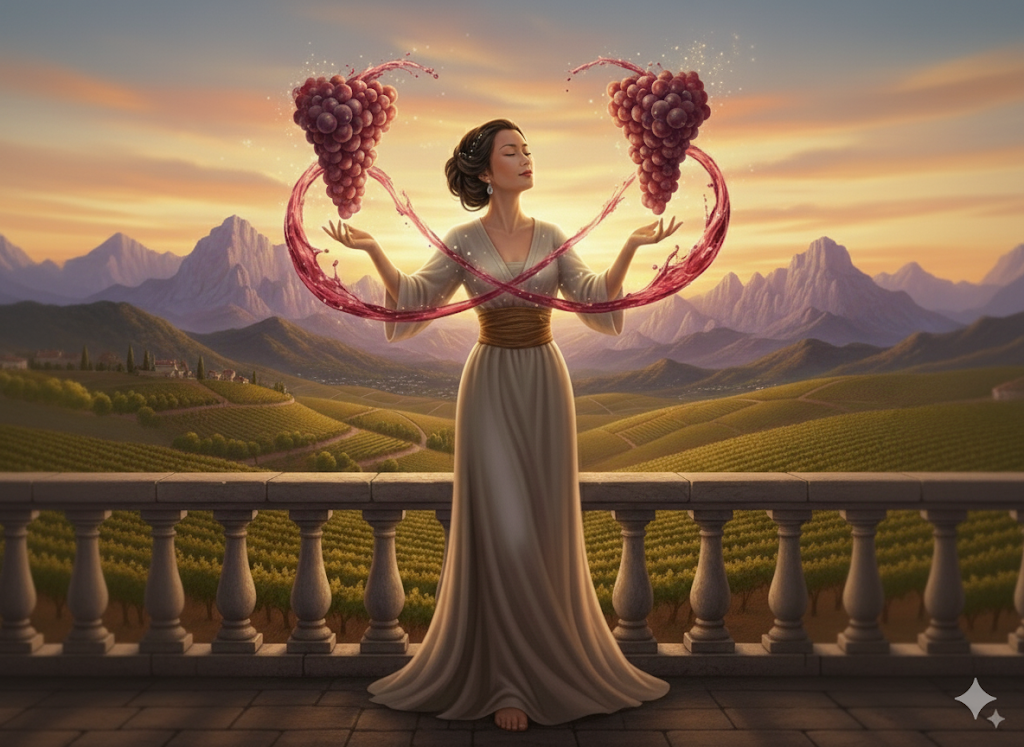Gigondas: Stone‑Born Ambition in the Southern Rhône
Gigondas, sheltered by the jagged Dentelles, crafts Rhône reds that marry furnace heat with alpine lift. Explore its path from Roman outpost to cru, taste the imprint of limestone, meet bold growers, and see why these wines mellow like cooling stone.

Overture: Stone and Sun Collide
They say the Rhône flows like a vein of molten memory, but it is in Gigondas where the river’s heat rises into bone‑white stone. Here, the Dentelles de Montmirail—a jagged crown of Jurassic limestone—lift the vineyards toward merciless light while casting sudden pockets of shade that feel almost earned. In that tension between scorch and respite, Gigondas wine finds its edges: muscular yet lifted, brooding yet alive.
Etched into Stone: A Spiral History
The Dentelles de Montmirail may wear their 200‑million‑year geology on the outside, but viticultural history here is a subtler palimpsest—each era overwriting the last, never quite erasing it. Before Rome, Ligurian tribes traded amphorae of fermented grape must that clung to the sharp resin of local pines. When Julius Caesar rewarded retiring legionaries with parcels of land in Gallia Narbonensis, Gigondas—then Jocunditas, “place of joy”—became a viticultural outpost on the Via Agrippa. Mosaic fragments unearthed near the current village square depict bunches of oversized grapes, the artistic boast of soldiers‑turned‑farmers eager to bottle permanence after years of campaign.
By the ninth century, Benedictine monks from Vaison‑la‑Romaine inherited these plots. They mortared low stone walls, carved terraces into garrigue, and documented each vintage in austere Latin that nevertheless pulses with weather‑borne anxiety. A 1116 entry laments a “great fiery wind” that stripped half the fruit—likely the Mistral, personified long before science charted its course.
The Avignon papacy (1309‑1377) swelled demand. Cardinals traveling the dusty corridor between Avignon and Die paused in Gigondas for a sturdier red—one unfazed by jostling coach wheels or ecclesiastical debate. Yet prestige proved fickle. By the seventeenth century, Châteauneuf‑du‑Pape had captured royal attention, leaving Gigondas to bulk trade. Its wines, shipped downriver in oxhide‑lined barrels, became anonymous cogs in négociant blends that warmed Lyonnais taverns but carried no name.
Calamity—and opportunity—arrived together. Phylloxera in the 1870s forced wholesale replanting; American rootstocks—dogged, resilient—underpin today’s vineyards. February 1956 brought a lethal frost that shattered centuries‑old olive trees. Vignerons, faced with decapitated groves, grafted hope onto heat‑hungry Grenache and altitude‑seeking Syrah and Mourvèdre.
Quality accelerated. Cooperatives modernized hygiene in the 1960s, while an insistent cadre of growers gathered lab analyses and tasting notes to petition Paris. On January 6, 1971, Gigondas became the first Southern Rhône village to leap from Côtes‑du‑Rhône Villages to full cru—its legal coronation after decades in the wings.
Since then, the narrative reads like a climbing graph: parcel selections, organic conversions, and the revival of whole‑cluster ferments. Yet the memory of marginality lingers. Walk the lanes at dusk and you’ll hear cellars humming, lids rattling on concrete tanks, growers debating how to keep balance as summers scorch and critics circle. History here is neither straight line nor closed loop—it’s a spiral etched into limestone, ascending, always, toward the next vintage.
Where Limestone Breathes and Heat Conspires
Stone‑born ambition—that is the phrase that echoes whenever I stand beneath the Dentelles. The uplifted reef acts as a heat sink by day and a cooling conduit by night, its porous limestone inhaling warmth and exhaling freshness. Below the cliffs sprawl three dominant soil families:
- Triassic red clay and marl in the lower terraces—iron‑rich, drought‑holding, urging Grenache toward plum‑skin density.
- Alluvial gravels swept down by Ouvèze floods—quick‑draining, stress‑inducing, sharpening Syrah’s blue‑violet perfume.
- Colluvial limestone scree at 300–600 m—white shards that glare back at the sun, reflecting light into the heart of late‑season Mourvèdre while evening Mistral winds comb away excess moisture.
Summer days often breach 35 °C, yet altitude and nightly katabatic breezes tether acidity. Rain rarely falls during harvest; when it does, the gullies flash like quicksilver, whisking danger downhill before botrytis can whisper.
Vines Schooled by Scarcity
Vines here are schooled by scarcity. Bush‑trained Grenache hunkers low, its canopy a sun‑shielding fist. On the higher slopes, Syrah sometimes climbs onto single wires, coaxed to reach light that Grenache finds oppressive. Organic and biodynamic farming now dominates—less as a marketing flourish than a practical acceptance that nothing artificial can out‑discipline rock and drought. Growers thin bunches ruthlessly; a hectare may yield only 30 hl, the equivalent of draining a small lake drop by drop.
Voices in the Glass
Grenache stands like a sun‑drunk captain at the prow, often commanding up to eighty percent of the blend yet rarely stealing the whole show. Rooted on the lowest terraces, its clusters swell into thick‑skinned orbs that hoard sunlight like iron hoards heat. Young, the grape speaks in a dialect of raspberry compote, roasted fig, and the bracing scent of hot stone after rain. Altitude edits excess: vines above 300 m curb sugar and channel a streak of blood‑orange acidity that keeps brawn from drifting toward blur.
Syrah enters from the fractured limestone mid‑slopes, where its tendrils reach skyward through stony pores. Here the grape swaps the violet perfume of northern latitudes for darker signals: blueberry pulp, cold hearth ash, cured olive. Even a splash—five or ten percent—threads tannin through Grenache’s swagger like wire through clay, tightening the wine’s posture without muting its voice.
Mourvèdre arrives last, both in bud break and in the glass, but it anchors the composition. On south‑facing scree it ripens to black‑tea density, contributing iron, smoked meat, and a seaside whisper that rides the mistral up from the Camargue. At fifteen percent it can pivot the palate from fruit‑forward to savory, steering the wine toward age‑worthy gravitas.
Minor actors amplify nuance: Counoise for lift, Cinsault for red‑berry levity, and a scattering of old‑vine Clairette rose that lingers from pre‑1971 field blends. Each element is small in measure but large in echo, expanding the wine’s timbre like overtones in a well‑struck bell.
Rosé makes up barely five percent of production—whisper‑pale yet structurally serious, drawn from saignée Grenache and direct‑pressed Cinsault. Imagine the inside of a white peach dusted with pink peppercorn, finishing on the stony snap of river quartz. Whites remain experimental, legally bottled as Côtes‑du‑Rhône blanc: Clairette, Bourboulenc, Grenache Blanc raised in sandstone‑lined demi‑muids, chasing a paradox—coolness coaxed from furnace heat.
Across Gigondas alcohol often nudges fifteen percent, yet the best bottles wear it like tempered armor—protective and articulated rather than ponderous. Tannin, once rustic, now resembles river‑polished pebble thanks to extended macerations and gentle press cycles. The result is a sensory seesaw: fruit weight against mineral clarity, solar ripeness against highland lift. That tension defines Gigondas, keeping its wines perpetually leaning forward, eager for the next sip.
Hands that Orchestrate Heat and Height
Gigondas is a stage tilted toward the sun, and every grower here choreographs the tension between heat and height. The script changes with each generation, yet the themes—stone, wind, restraint—remain as fixed as the saw‑tooth skyline.
The Historic Pillars | Custodians of memory
Château de Saint Cosme has worked these slopes since the Renaissance, its cellar a catacomb of sandstone vats large enough to swallow echo. Louis Barruol prizes whole clusters and low‑tech ferments; his single‑parcel cuvées—Le Claux, Hominis Fides, Le Poste—read like limestone, marl, and sand in dialect conversation. A short ride away, Domaine Santa Duc balances power with altitude. Organic farming, partial amphora élevage, and foudres big as village chapels yield wines that stride rather than stomp—Les Hauts de Montmirail and Clos Derrière Vieille show the house’s gift for taming Grenache’s furnace without icing its fire.
Few estates cling to tradition as faithfully as Domaine du Cayron, where the Faraud sisters still foot‑tread Grenache from goblet vines planted by their grandfather. Ageing occurs in ancient foudres that smell of cedar and evening rain; the resulting wine wraps plum skin and thyme around a spine of dust‑fine tannin. Pierre Amadieu, by contrast, is Gigondas at scale: 120 ha spread from 200 to 400 m. Altitude is Amadieu’s silent partner, furnishing freshness to blends like Le Pas de l’Aigle and La Paillère et Pied Gu. Domaine Raspail‑Ay, a ten‑hectare jewel box, makes but one red—a cuvée that spends two winters in large oak, emerging as bottled garrigue with a flicker of blood orange.
Modern Standard‑Bearers | Precision without polish
Julien Bréchet of Domaine des Bosquets farms organically, harvests by parcel and sub‑parcel, and lets gravity move must through a split‑level cellar. New oak is nearly absent; concrete, amphora, and seasoned barrels frame lieu‑dits like Le Lieu Dit and La Colline. At Domaine Saint Damien, biodynamics guide cover‑crop choices and picking dates; partial whole‑cluster ferments bring rose‑hip perfume and silty tannin to wines that glow more than they growl. Mountain‑perched Domaine La Bouïssière and neighbor Clos du Joncuas leave stems intact and macerate for a moon cycle, translating altitude into tensile strength rather than bulk.
Up‑and‑Comers to Watch | New verses in an old song
At Domaine Longue Toque micro‑parcel ferments in 600‑L demi‑muids highlight subtle soil shifts, while trials with submerged‑cap ferments tease out floral tones from sun‑black fruit. Domaine La Bastide Saint Dominique experiments with partial carbonic maceration, coaxing red‑currant brightness into Grenache without sacrificing the mineral bass line. And on the highest scree, Domaine du Terme—once a quiet cooperative supplier—now bottles its own plots, ageing in sandstone eggs that lend a subtle hush of reduction before the wine unfurls.
Shared Threads
Across these cellars certain constants persist: large neutral vessels keep fruit and stone in dialogue; sulfur is dosed with an eyedropper; and irrigation remains taboo. Leaves are pulled early on low terraces to thicken skins, yet left draped like cathedrals on high slopes where the sun is razor sharp. Yields rarely top 35 hL/ha—not marketing bravado, just climatic math.
Every producer solves the same equation—Heat × Height = Balance—with their own variables: stems, harvest dates, amphora, altitude. The results differ in accent but share a dialect: wines that flex biceps yet breathe mountain air, carrying the echo of stone long after the glass is empty.
Time's Long Arc: Caring for Gigondas
Even in torrid years these wines ride on a hidden backbone—serve them too warm and you amputate that spine. 16–18 °C (60–64 °F) is ideal; decant younger vintages for an hour to tame savoury tannin, but keep older bottles upright for a day and pour gently: the sediment is fine as Rhône dust. Peak drinking generally spans 8–20 years; yet I have tasted 1978s still strumming a low minor chord. If you lay Gigondas down, lay it flat, cool, dark, and patient—the wine ages the way cliffs erode: slowly, by degrees, but unmistakably.
Collect Gigondas not to flip but to witness. Its value is cultural: a testament that grandeur can spring from adversity—heat, stone, the periphery of fame. Owning these bottles is like holding field notes from a frontier that learned its own language while older capitals slept. Memory, not speculation, is the currency here; the return is measured in the widening eyes of friends who thought Southern Rhône began and ended with Châteauneuf.
Gigondas lets us do just that—through stone, through heat, through wine.
Furnace Meets Cliff
Elevation holds the line in Gigondas, but heat tests that line every vintage. Out of that contest emerges a wine of bruised fruit and bracing lift, a wine that feels like night air cooling sun‑burned skin. Drink it, and you taste ambition chiselled into rock—proof that beauty sometimes demands both furnace and cliff to find its final form.





